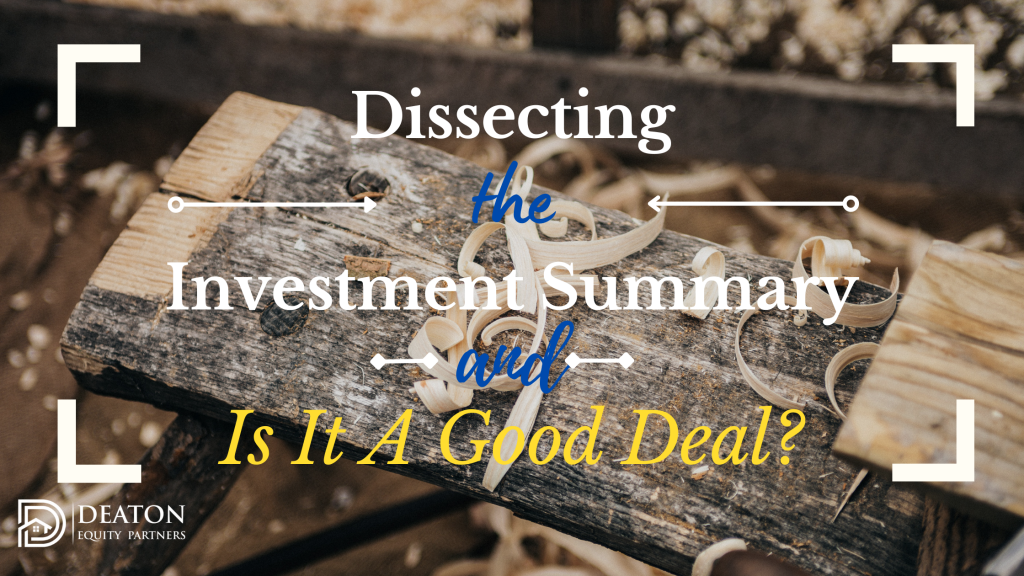Dissecting Investor Summaries
What To Look For And
How To Tell When A Deal Is “Good”
Investment summaries.
I have yet to see one that leads with an intro “this isn’t a very good investment, but we still hope you’ll invest in it because we really like it.” They are all packaged up with slick graphics, colorful charts and punchy lingo. And in a world where our attention is perhaps the most valuable commodity and investment opportunities compete with one another, how could you expect anything less.
However, given that, how are investors supposed to separate the wheat from the chaff, as they say, to take away the essential points and make an informed decision?
And while each investment summary inherently unique (some are image heavy while others more like an economics textbook), they do all target to portray the same fundamental information; and that’s where we can apply focus to pull out those essential details to see and understand the real investment opportunity.
just how are investors supposed to separate the wheat from the chaff?

So if you decide to invest because the investment summary looks pretty, you are putting yourself at risk, especially if you haven’t done proper due diligence on the deal and the team.
Likewise, if you pass on a deal because the investment summary looks like Elon Musk’s tax returns from last year and the material causes your eyes to glaze over, you might be missing out on a great opportunity.
So what exactly should you look for? Good question.
Let’s take a look at a sample investment summary. I’ll walk you through the thought process I go through when I first review an investment summary, so you’ll know what to look for the next time one lands in your inbox.
**Please note: For simplicity’s sake in this example, I’m assuming the summary is a very brief document, rather than a full-blown investment summary, which could be dozens of pages long.
The Investment Summary At A Glance
Even though every investment summary is different, there are some basic elements that are common across all multifamily real estate syndication investment summaries:
- Project name (often the name of the apartment complex)
- Photos of the property and area
- Overview of the submarket
- Overview of the investment
- Details of the business plan
- Projected returns and exit strategies
- Detailed numbers and analyses
- Team biographies
In a one-page executive summary, you usually get a little bit of each of these elements. It’s a first date. If going forward, you definitely want to get the full investment summary and review all the details as well as ideally attend a webinar to have the opportunity to ask questions.
If this executive summary landed in my inbox, I’d start with a quick read-through.
In skimming this executive summary, here are the things that would jump out at me:
- Off-market
- Value-add
- Reference to a track record
- Strong submarket
- Proven model
- Equity multiple
- Unit count
Off-Market
When an asset is acquired off-market, it means that the seller chose not to list the asset publicly. Maybe the seller didn’t want the tenants to know that the building was being sold (this is quite common). Maybe the seller needed to sell within a set timeline. Or maybe the seller already had a buyer in mind.
Regardless, off-market is almost always a good thing. This means the deal sponsor team did not have to compete with other potential buyers on price. Thus, there’s a good chance that the purchase price is low, or at least reasonably below the market value.
Value-Add
A value-add investment is exactly what it sounds like – an asset that presents an opportunity to add value in some way. Maybe the rents are significantly below market rates because the previous owner hasn’t raised rents in 10 years. Maybe the kitchens & fixtures are still from the ’80s and could use some updating. Maybe there’s an opportunity to add some brand-new additional units.
Whatever the case may be, value-add means more control is in the hands of the deal sponsor team. Rather than relying solely on market appreciation, there are things they can do to create additional equity, even if the market stagnates. This is known as forced appreciation.
One of the most common value-add scenarios is one in which the units need to be updated. Let’s say the apartments haven’t been updated in 10 years, and the current rents are $1,000 per month. Even if the team were to stay the course, that $1,000 per unit would still be able to cover the mortgage and fetch a modest profit.
But, who gets excited to make a “modest” profit?
Because there’s a chance to add value through improved living conditions, as well as increase the returns for investors, this is a true value-add. The team will go in, complete the renovations, then rent out the updated units for, let’s say, $1,200 per month.
When you add up the $200 per month increases across all 250 units, that creates so much value for all parties involved. When residents see the updated spaces, they’re often happy to pay slightly higher rents for a nicer home and they start to take more pride in their community. For the investors, they get to share in a tremendous amount of increased equity from those improvements.
Property values for commercial real estate are driven by income. That extra $200 across 250 units across 12 months amounts to an additional $600,000 in revenue! Not bad at all. And the kicker? That increased revenue multiplies the property value with a constant known as the cap rate. Cap rates fluctuate by market, but even if we use one that’s very conservate, like 10% (easy math 😊), the actual increased value in the property is $6,000,000! That’s the beauty of value-add.
Track Record
The next thing that catches my eye is, “Similar to Beta Apartments (acquired just last year and currently undergoing renovations)…” This tells me that this is not this team’s first rodeo. They’ve done this before and are currently in the trenches with another asset nearby.
I also see, in the Investment Highlights section, that they’ve started implementing their business plan at Beta Apartments and that they’re surpassing their original projections. This tells me that their business plan is working and that they would likely be able to continue to strengthen their track record through Omega Apartments.
Further, this tells me that they’ve likely built up a strong reputation in the area, amongst brokers, property managers, and other apartment owners. Otherwise, they wouldn’t have been awarded this off-market deal.
Strong Submarket
I don’t know about you, but if I’m going to invest in an apartment building, I want it to be in a growing and developing area.
The fact that this submarket is the “#1 fastest growing” within this fictional metropolitan area tells me that things are moving and shaking here. I would likely open a new browser tab and immediately google that metro area and that particular submarket, to learn more about them.
What am I looking for? Things like proximity to major employers in the area, shopping centers, decent schools, any news about developments in the area, what it looks like on Google street view, what nearby houses are selling for, and anything else I can find.
Much of this will be in the full investment summary, but it’s always a great idea to do a little independent research on your own as well. Trust, but verify…especially when we’re talking investment amounts like these.
Proven Model
Did you catch it? “Ten units have already been updated and are achieving rent premiums of $150.” Jackpot.
Why is this so important? This takes much of the guesswork and assumptions out of the value-add proposal. The previous owner already created the proof of concept. They updated a set amount of units, and they were able to get the higher rents.
This is great news. This means that all we have to do is go in and continue those renovations to achieve those same rental increases. To me, this signals much lower risk in a value-add opportunity.
Equity Multiple
There are certainly lots of numbers in any investment summary, and they can be overwhelming. Percentages, splits, projected returns, waterfalls…what do they all mean?
One metric I’ve come to rely on is the equity multiple. For me, the equity multiple is the real bottom line return that cuts through the other figures. In this case, the projected equity multiple is 2.1x. This means that during the life of this project, my money will be more than doubled.
That is, if you were to invest $100,000, you would come out of this project with $210,000.
This $210,000 would include your original $100,000 investment, as well as $110,000 of profits. This $110,000 would include the quarterly cash-on-cash returns you would be getting as long as the asset is held, as well as your portion of the profits from the sale of the asset.
Typically, I look for an equity multiple around 2x over 5 years, so this one passes my test.
Unit Count
I always like to know how many units I’m investing in. In this case, Omega Apartments consists of 250 units. This is a pretty decent size. This means that the team would be able to take advantage of economies of scale (i.e., increasing efficiencies by leveraging shared resources across the many units).
I will typically look at anything above 75 units. Ideally, to maximize economies of scale, I like to see over 100 units.
Next Steps…
Now that I’ve taken the initial look through the executive summary, my immediate next step would be to decide whether or not to request the full investment summary.
In this case, I would go ahead and request the full investment summary, as this opportunity ticks off most, if not all, of the things I look for in a multifamily investment opportunity – strong team, strong submarket, opportunity to add value and a >2x equity multiple.
In the meantime, I would do some more research on both the submarket and the deal sponsor team. I would definitely google Alpha Investments and read about the core people on their team, learn about other assets in their portfolio, and see if I can find any negative reviews or stories out there about the individuals or the team.
Be Ready to Move Quickly
Once you find an investment summary that meets your investment criteria, it’s critical that you move quickly. Why? Because these opportunities fill up on a first-come, first-served basis.
Chances are, if this investment opportunity met your criteria, it likely met others’ criteria as well. In that case, you’ll want to be ready to make a soft commitment to reserve your spot, then take that additional time to review the investment summary in detail.
Pro tip: There’s no penalty for backing out of an investment down the road, so it’s to your benefit to reserve early, to ensure you get a spot in the deal. If you wait around to be 110% sure, others will have jumped in front of you in line, and you may be left on the backup list.
Request a Full Investment Summary Sample
If you’re interested in seeing a sample of a full investment summary, or to gain access to the deals in our pipeline, consider signing up for the Deaton Equity Partners Passive Investor’s Group.
We are here to support you in your investment journey and will never pressure you to invest. Our goal is to help you gain the knowledge you need to invest with confidence (whether in our deals or someone else’s), so that together, we can change the world, one investment at a time.



